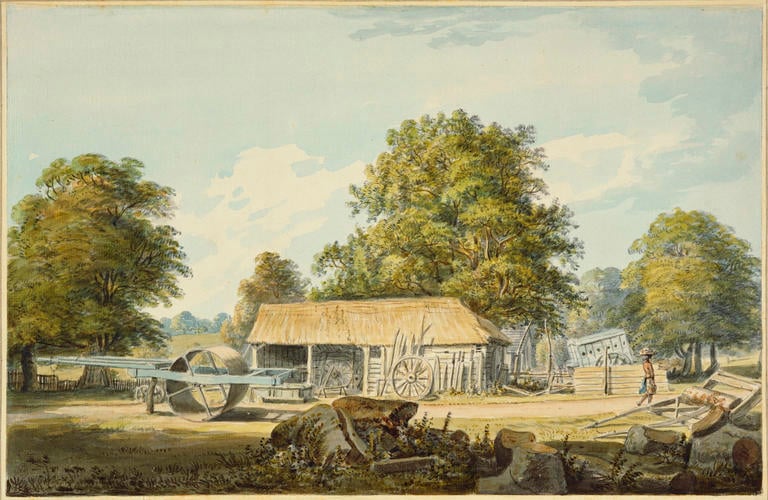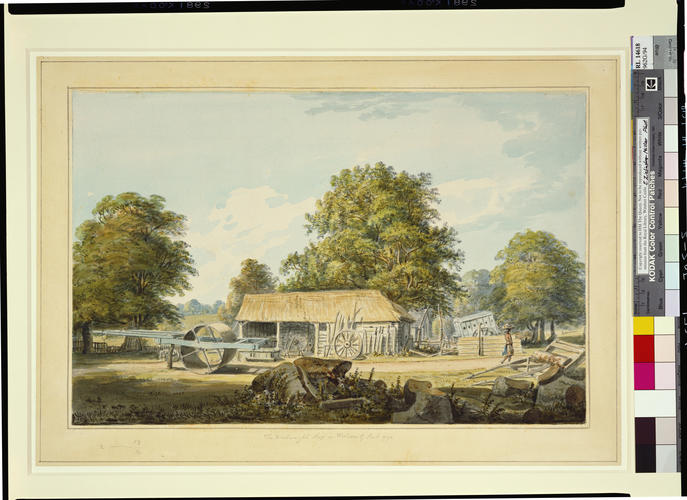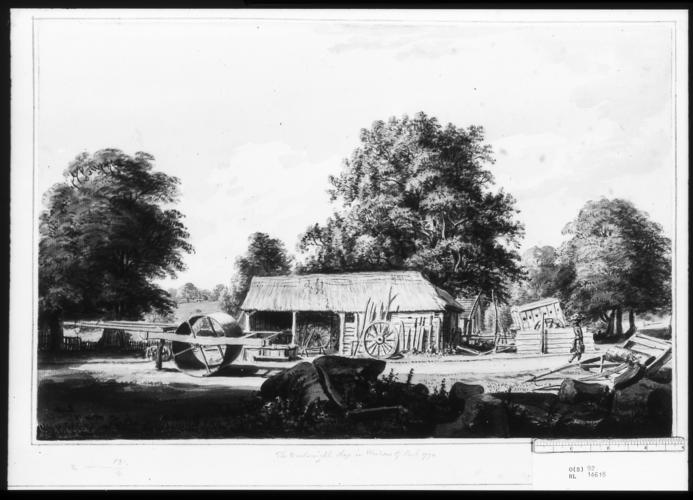Paul Sandby (1731-1809)
The Wheelwright's Shop in Windsor Great Park signed & dated 1792
Pencil and watercolour | 27.7 x 42.7 cm (sheet of paper) | RCIN 914618
-
A pencil and watercolour drawing of a thatched shed in a clearing, with wheels leaning against its walls. Two rollers on the grass. A figure with basket on his head and another in his hand on the right. Inscribed on logs in the foreground: 'Wood Yard W. P.' and 'P.S. 1792'. Mounted on a sheet with two ink lines, inscribed in pencil: The Weelwright's [sic] shop in Windsor G. Park 1792, with an auctioneer's lot number 2—13/2. EVII stamp lower left corner (Lugt 901).
The drawing is among several that Sandby made of the workshops around the woodyard in Windsor Great Park, many of which are dated 1792. He exhibited two 'Views in the Woodyard, Windsor Great Park' at the Royal Academy in 1793 (nos 541 and 603), one of which is 451587. Other views of the Woodyard in the Royal Collection are 914620, 914621, 917308, 914619 and 914613; five drawings of the woodyard in the British Museum are 1904,0819.110, 1904,0819.97, 1904,0819.120, 1904,0819.59, 1904,0819.24. Others include a watercolour sold at Sotheby's 6 July 2010 (lot 40), a watercolour in the City of Hamilton Art Gallery, Victoria, Australia (inv. no. 1133), a watercolour in Leicestershire Museum and Art Gallery (7a.1904) and a watercolour in the Yale Center for British Art, New Haven (B1975.4.1383). 914621 is in a similar mount with price mark and was bought as the same lot at Sandby's estate sale.
The woodyard with its carpenters' workshops and wheelwrights' shop was near to the Deputy Ranger's House occupied by Thomas Sandby in Windsor Great Park. The yard was moved to an area further west in the nineteenth century. The yard produced timber for building works across the estate, including fencing and farm machinery. Bruce Robertson has suggested that Sandby made these drawings en plein air during a period of convalescence at his brother's house (The Art of Paul Sandby, exh. cat., New Haven 1985, no. 126). Others (Sotheby's, 6 July 2010, lot 40) have seen these works as evidence of Sandby's affection for the unsung aspects of life on country estates. John Bonehill and Stephen Daniels (Picturing Britain, exh. cat., Nottingham &c 2009, p. 226) have pointed out that Sandby's concentration on the subject of the woodyard coincides with the outbreak of the Napoleonic wars and the felling of large numbers of trees for naval timber; these drawings are thus connected to wider patriotic concerns. In a letter to James Gandon, Sandby wrote that 'the majestic forests of Windsor have long since lowly bowed their heads to the adze of keen necessity, and lust of lucre', with the 'humble elm' lending 'feeble aid to battle with our enemies at sea' (Gandon 1846, p. 184). The development of the Windsor estate in this period was also seen as a sign of the country's benevolent constitution and virtuous sovereign.
Provenance
Paul Sandby estate sale, 4-6 May 1811, lot 13; bought 'Shepperd' for the Prince of Wales when Prince Regent (2 1/2 gns)
-
Creator(s)
Acquirer(s)
-
Medium and techniques
Pencil and watercolour
Measurements
27.7 x 42.7 cm (sheet of paper)
Other number(s)
RL 14618










